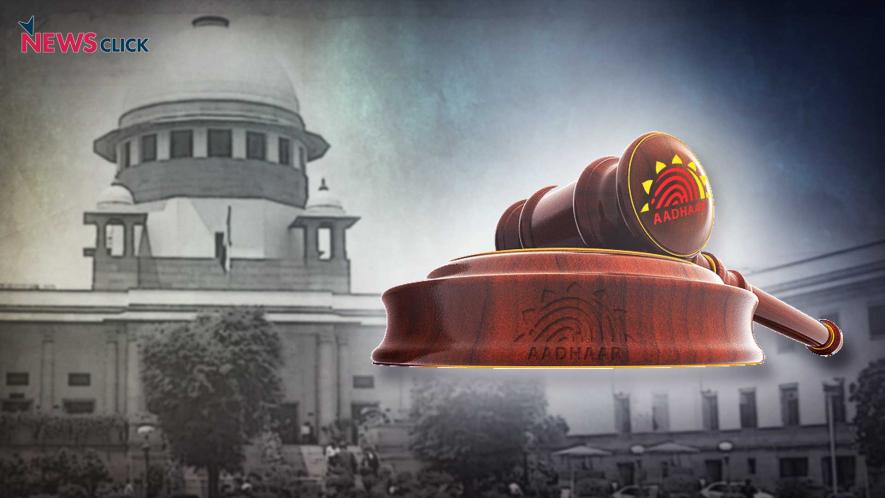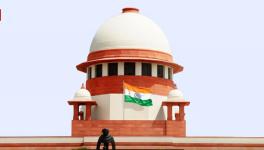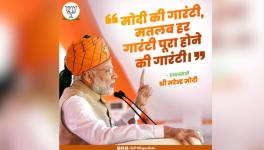The Spurious Claims of the Union Government on Aadhaar Debunked in Court

Newsclick Image by Nitesh Kumar
On January 30, day 5 of the hearings on Aadhaar, Advocate Shyam Divan explained to the Court the process of data aggregation, and how it is unavoidable under Aadhaar. The Union of India subsequently filed an affidavit in which several claims were made. On day 6 of the hearings, February 1, the petitioners systematically debunked each of the claims of the Government using RTI information among other sources.
As per the written submissions available on Live Law, the respondents in the case had two main reasons to justify the Aadhaar project. The first reason cited was that millions of Indians had no acceptable identification and that Aadhaar would remedy this. The second reason was that the de-duplication process ensures massive financial savings by plugging leakages in welfare programs.
Responding to the first contention the counsels for the petitioners provided statistics available in the public domain to disprove the claim of ‘millions’ without valid identification. The first point was that the currently existing system for receiving Aadhaar for people without identity documents is the ‘introducer system’. The introducer system relies on the person without identity documents being ‘introduced’ by another person who has such documents. On the basis of the introducer’s statements, they will receive the documents.
The contention of the petitioners was that the data of such people enrolled through the introducer system is a strong indicator of how many people were without such documents. Through an affidavit affirmed by the Director of UIDAI, Ghanraj Singh Shekhawat in 2015, 2,13,000 people were enrolled through the introducer system. The total enrolments at the time stood at 80.46 crores. This meant that around 0.03% of those who had applied, had done it through the introducer system. In response to an RTI application in 2016, the UIDAI stated that 8,47,366 Aadhaar numbers had been generated through the introducer system, a figure comprising 0.08% of those who had enrolled. In this regard, the petitioners argued that such a low percentage of people who were without documents cannot be a basis for invading the privacy of so many others.
In response to the second reason in the respondent’s affidavit, the petitioners listed three reasons for leakages; ineligibility of the beneficiary, fraud in the quantity disbursed whether as commission or not, and identity fraud. The petitioners stated that Aadhaar can only help in plugging the third category of leakage, i.e. identity fraud. The petitioners challenged the claim of the World Bank Report cited by the respondents. The Report had claimed Aadhaar had saved the Government 11 billion USD per annum. However, the Report had cited a 2015 paper which stated that the transfers for five schemes were roughly Rs. 70,000 crores or 11.3 billion USD at the time. Nowhere in the paper had the author mentioned any savings arising out of Aadhaar.
The Government had claimed savings of 3,000 crores in MGNREGS in 2014-15. UIDAI data showed that in 2014 67,637 job cards were found to be bogus. However, all the cards found to be bogus were in one state, Tripura. In response to an unstarred question in the Lok Sabha in 2015, the Union Minister of Rural Development stated that 63,943 job cards had been found to be duplicates and were eliminated. Doing the math, it would amount to Rs 200 x 100 days x 63,943 bogus job cards, which results in a figure of around 127.89 crores, a fraction of the savings the Government has claimed.
On the issue of savings in the LPG subsidy, the Government claimed savings of 14,672 crores in 2014-15, 6,912 crores in 2015-16, and 4,824 crores in 2016-17. The petitioners challenged the claim citing minutes of a 2015 Cabinet Secretariat meeting which stated 91 crores was saved. The petitioners also referred to de-duplication exercises undertaken by oil marketing companies along with the National Informatics Commission in 2012 before the rollout of Aadhaar. They referred to a 2016 CAG report where it stated that de-duplication cannot be attributed solely to Aadhaar through the PAHAL (DBTL) scheme.
Regarding savings in the PDS system, the Government claimed 14,000 crores was saved between 2016-17 as a result of DBT through Aadhaar. However, in 2016 responding to an unstarred question in the Lok Sabha the Union Minister of Consumer Affairs, Food and Public Distribution stated that the elimination of forged, fraudulent, duplicated ration cards did not result in any reduction of allocated funds disbursed through the PDS. Therefore, in this regard the question of savings does not arise.
Get the latest reports & analysis with people's perspective on Protests, movements & deep analytical videos, discussions of the current affairs in your Telegram app. Subscribe to NewsClick's Telegram channel & get Real-Time updates on stories, as they get published on our website.
























